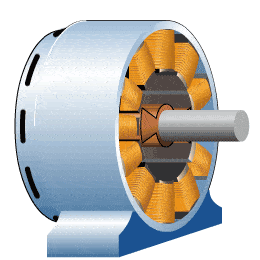Abnormal sound occurs when the motor is running
The motor has large vibration during operation
After the electric motor can not rotate, but no noise, no odor and smoke
The motor does not rotate after energizing, and then the fuse is burned off
There is humming sound when the motor does not rotate after power-on
The motor's no-load current is unbalanced, and the three items differ greatly
When the motor is unloaded and overloaded, the ammeter pointer is unstable and wobbles
The motor's no-load current is balanced, but the value is large
It is difficult for the motor to start. When the rated load is used, the speed is much lower than the rated speed
The motor overheats or even smokes
1. Abnormal sound occurs when the motor is running
1) Fault cause ① Rotor and stator insulation paper or groove wedge rub; Bearing wear or oil sand and other foreign bodies; ③ The fixed rotor core is loose; (4) bearing oil shortage; (5) Air duct packing or fan wipe hood; The rotor core phase rub; ⑦ power supply voltage is too high or unbalanced; The stator windings are misconnected or short circuit.
2) ① Trim the insulation and cut the groove wedge; (2) Replace bearings or clean bearings; ③ Repair and repair fixed and rotor core; (4) Come on; (5) Clean the air duct; Remount; ⑥ eliminate scratches, if necessary, small rotor inside the car; ⑦ Check and adjust the power supply voltage; ⑧ eliminates stator winding faults.

2. The motor has large vibration during operation
1)Fault reasons (1) due to wear bearing clearance is too large; ② Uneven air gap; ③ Rotor unbalance; (4) the rotating shaft is bent; ⑤ Deformation or loosening of the iron core; The coupling (pulley) center is not corrected; ⑦ fan imbalance; Housing or foundation strength is not enough; ⑨ The motor anchor screws are loose; ⑩ Cage rotor welding open circuit; Wound rotor break; The stator winding is faulty.
2)Troubleshooting (1) Overhaul the bearing and replace it if necessary; ② Adjust the air gap to make it uniform; (3) Correcting rotor dynamic balance; (4) alignment of the rotating shaft; ⑤ Correcting overlapping core; ⑥ Recalibrate to make it conform to the regulations; ⑦ Overhaul the fan, correct the balance, correct its geometry; ⑧ to reinforce; ⑨ Tighten the anchor screws; ⑩ Repairing the rotor winding; Repair the stator winding.
3. After the electric motor can not rotate, but no noise, no odor and smoke
1) Fault reasons ① The power supply is not connected (at least two phases are not connected); ② fuse is broken (at least two phases); (3) Overcurrent relay is too small; (4) The control device is incorrectly connected.
2) Troubleshooting (1) Check the power circuit switch, fuse, junction box whether there is a breakpoint, repair; (2) Check the fuse type and the reason for fusing, and replace the fuse; (3) Adjust the setting value of the relay and the motor; ④ Correct the wiring.
4. The motor does not rotate after energizing, and then the fuse is burned off
1. The cause of the failure (1) lack of a phase power supply, or fixed line ring a reverse connection; (2) short-circuit between stator windings; (3) stator winding grounding; (4) Incorrect wiring of stator winding; (5) The fuse section is too small; ⑥ The power cable is short-circuited or grounded.
2. Troubleshooting (1) Check whether there is a phase of the brake is not closed, but there is a phase break in the power loop; Eliminate the reverse connection fault; ② Find out the short circuit point, to repair; (3) Eliminate grounding; (4) Find out the wrong connection and correct it; ⑤ Replace the fuse; ⑥ Eliminates the ground point.
5. There is humming sound when the motor does not rotate after power-on
1. Fault cause (1) stator, rotor winding has a break (a phase break line) or a power supply phase loss; ② The beginning end of the winding exit wire is connected incorrectly or the winding internal connection is reversed; (3) The contact point of the power circuit is loose, and the contact resistance is large; ④ the motor load is too large or the rotor is stuck; ⑤ The power supply voltage is too low; The assembly of small motor is too tight or the grease in the bearing is too hard; ⑦ The bearing is stuck.
2. Troubleshooting ① Identify the break point and repair it; ② Check the polarity of the winding; Judge whether the winding end is correct; (3) Tighten loose wiring screws, use a multimeter to determine whether the joints are false and repair them; (4) reduce the load or find out and eliminate mechanical faults; ⑤ Check whether the specified Δ connection method is also misconnected to Y; Whether the voltage drop is too large due to too thin power supply wire, to correct; ⑥ Reassemble to make it flexible; Replacement of qualified grease; ⑦ Repair bearings.
6. The motor's no-load current is unbalanced, and the three items differ greatly
1. Fault cause ① The number of turns of stator three-phase winding is not equal during rewinding; ② the head and end of the winding are connected incorrectly; (3) power supply voltage imbalance; ④ the winding has inter-turn short circuit, coil reverse connection and other faults.
2. Troubleshooting ① Rewind the subwinding; ② Check and correct; ③ Measure the power supply voltage and try to eliminate the imbalance; ④ remove winding fault.
7. When the motor is unloaded and overloaded, the ammeter pointer is unstable and wobbles
1. Fault reasons ① Cage rotor guide bar welding or broken bar; (2) Wound rotor fault (a phase break) or brush, collector ring short circuit device contact is bad.
2. Troubleshooting ① Find out the broken bar to repair or replace the rotor; ② Check the loop around the rotor and repair it.
8. The motor's no-load current is balanced, but the value is large
1. Fault cause ① The number of turns of stator winding is reduced too much during repair; (2) The supply voltage is too high; (3) The Y-connected motor is mistakenly connected to Δ; (4) In motor assembly, the rotor is inverted, so that the stator core is not aligned, and the effective length is shortened; (5) The air gap is too large or uneven; When overhauling and removing the old winding, the use of thermal disassembly method is improper, so that the core burns.
2. ① Rewind the stator winding to restore the correct number of turns; ② Try to restore the rated voltage; ③ Change it to Y; ④ Reassemble; Replace the new rotor or adjust the air gap; ⑥ Overhaul the iron core or recalculate the winding, and increase the number of turns appropriately.
9. It is difficult for the motor to start. When the rated load is used, the speed is much lower than the rated speed
1. ① The power supply voltage is too low; (2) The δ-connected motor is mistakenly connected to Y; ③ Cage rotor opening welding or fracture; (4) The local coil of the rotor is misconnected or reversed; (5) The number of turns increased too much when repairing the motor winding; ⑥ Motor overload.
2. ① Measure the power supply voltage and try to improve it; ② corrective connection; ③ Check the opening welding and breakpoints and repair; (4) Find out the wrong connection and correct it; ⑤ Restore the correct number of turns; ⑥ Load reduction.
10 The motor overheats or even smokes
1. Fault cause ① The power supply voltage is too high, so that the heating of the iron core is greatly increased; (2) The power supply voltage is too low, and the motor runs with rated load, and the winding heats up when the current is too high; (3) When repairing and removing winding, improper thermal dismantling method is used, which burns the iron core; (4) stator core rub; ⑤ The motor is overloaded or starts frequently; ⑥ Cage rotor broken bar; ⑦ The motor lacks phase, two-phase operation; ⑧ rewound due to the winding immersion paint is not sufficient; ⑨ High ambient temperature motor surface dirt, or ventilation channel blocked; ⑩ Motor fan failure, poor ventilation; Stator winding fault (short circuit between phases and turns; Internal connection error of stator windings).
2. (1) Reduce the power supply voltage (such as adjusting the power supply transformer connector), if the motor Y, Δ connection error caused, it should be corrected; ② Increase the power supply voltage or change the coarse power supply wire; ③ Overhaul the iron core and troubleshoot; (4) Eliminate the friction point (adjust the air gap or file, the rotor); (5) Load reduction; Start control according to the specified number of times; ⑥ Check and eliminate rotor winding fault; ⑦ Restore three-phase operation; ⑧ using two immersion paint and vacuum immersion paint process; ⑨ Clean the motor, improve the ambient temperature, and adopt cooling measures; ⑩ Check and repair fans and replace them if necessary. Check and repair stator windings to eliminate faults.
11 The motor bearing is overheating
1. Fault reasons (1) too much or too little grease; (2) poor oil containing impurities; (3) The bearing and the journal or the end cap are not matched properly (too loose or too tight). (4) The bearing inner hole is eccentric, and the shaft is rubbed; (5) Motor end cover or bearing cover is not installed flat; The coupling between the motor and the load is not corrected, or the belt is too tight; Bearing clearance is too large or too small; ⑧ The motor shaft is bent.
2. Troubleshooting (1) Add grease (1/3-2/3 of the volume) according to the regulations; ② Replace clean lubricating grease; (3) Too loose can be repaired by binder, too tight should be the car, grinding journal or end cap hole, so that it is suitable; (4) Repair the bearing cover to eliminate rub points; ⑤ Reassemble; ⑥ readjust and adjust the belt tension; ⑦ Replace new bearings; ⑧ Correct the motor shaft or replace the rotor.
English
Русский
العربية
Français
Español
Português
Deutsch
italiano
日本語
한국어
Nederlands
Tiếng Việt
ไทย
Polski
Türkçe
አማርኛ
Bahasa Melayu
தமிழ்
Filipino
Bahasa Indonesia
magyar
Română
Čeština
हिन्दी
فارسی
Kiswahili
Slovenčina
Slovenščina
Norsk
Svenska
українська
Ελληνικά
Suomi
עברית
Dansk
বাংলা
Hrvatski
Afrikaans
Gaeilge
Eesti keel
Māori
සිංහල
Azərbaycan dili
Euskara
Беларуская мова
Български
guarani
Kreyòl ayisyen
Kurdî
Lietuvių
Македонски
తెలుగు















